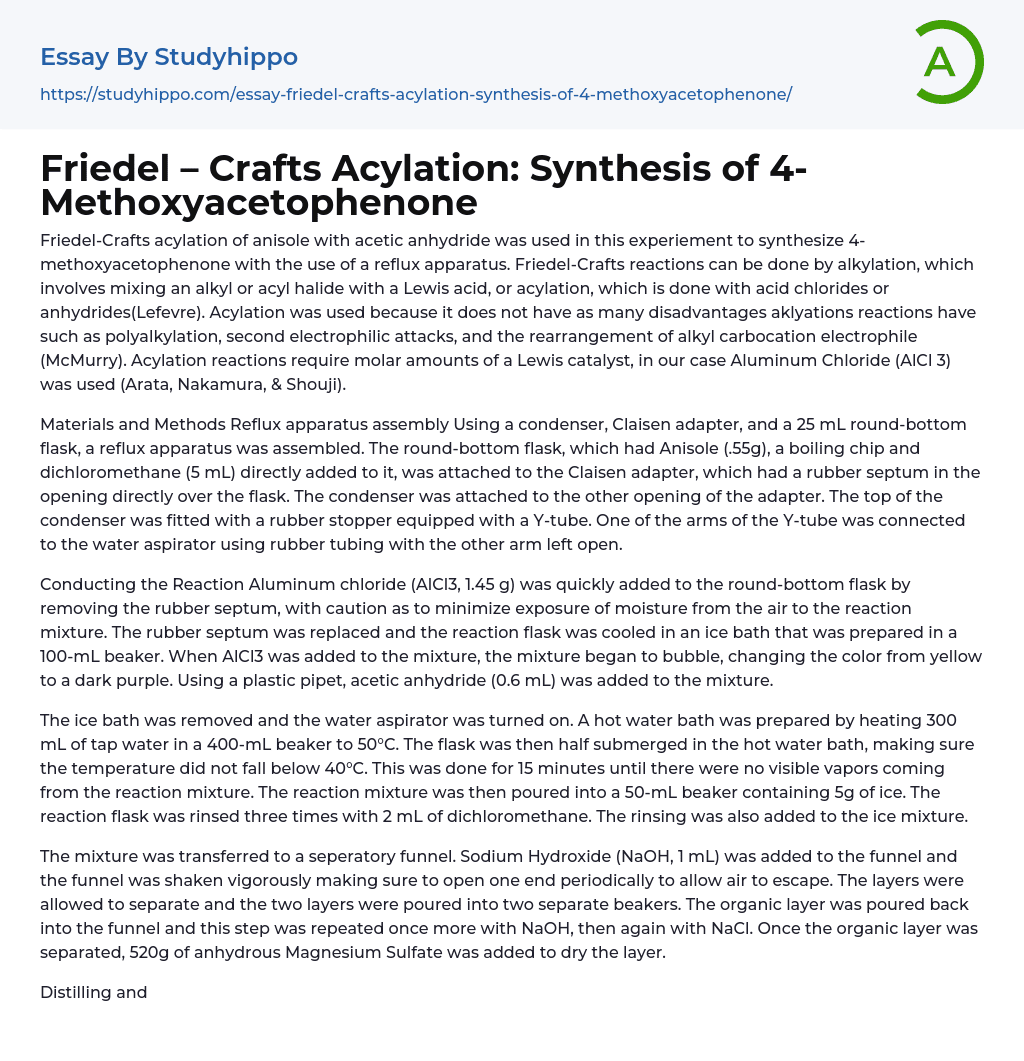

Friedel – Crafts Acylation: Synthesis of 4-Methoxyacetophenone Essay Example
Friedel-Crafts acylation of anisole with acetic anhydride was used in this experiement to synthesize 4-methoxyacetophenone with the use of a reflux apparatus. Friedel-Crafts reactions can be done by alkylation, which involves mixing an alkyl or acyl halide with a Lewis acid, or acylation, which is done with acid chlorides or anhydrides(Lefevre). Acylation was used because it does not have as many disadvantages aklyations reactions have such as polyalkylation, second electrophilic attacks, and the rearrangement of alkyl carbocation electrophile (McMurry). Acylation reactions require molar amounts of a Lewis catalyst, in our case Aluminum Chloride (AlCl 3) was used (Arata, Nakamura, & Shouji).
Materials and Methods Reflux apparatus assembly Using a condenser, Claisen adapter, and a 25 mL round-bottom flask, a reflux apparatus
...was assembled. The round-bottom flask, which had Anisole (.55g), a boiling chip and dichloromethane (5 mL) directly added to it, was attached to the Claisen adapter, which had a rubber septum in the opening directly over the flask. The condenser was attached to the other opening of the adapter. The top of the condenser was fitted with a rubber stopper equipped with a Y-tube. One of the arms of the Y-tube was connected to the water aspirator using rubber tubing with the other arm left open.
Conducting the Reaction Aluminum chloride (AlCl3, 1.45 g) was quickly added to the round-bottom flask by removing the rubber septum, with caution as to minimize exposure of moisture from the air to the reaction mixture. The rubber septum was replaced and the reaction flask was cooled in an ice bath that was prepared in a 100-mL beaker. When AlCl3 was added to the mixture,
the mixture began to bubble, changing the color from yellow to a dark purple. Using a plastic pipet, acetic anhydride (0.6 mL) was added to the mixture.
The ice bath was removed and the water aspirator was turned on. A hot water bath was prepared by heating 300 mL of tap water in a 400-mL beaker to 50°C. The flask was then half submerged in the hot water bath, making sure the temperature did not fall below 40°C. This was done for 15 minutes until there were no visible vapors coming from the reaction mixture. The reaction mixture was then poured into a 50-mL beaker containing 5g of ice. The reaction flask was rinsed three times with 2 mL of dichloromethane. The rinsing was also added to the ice mixture.
The mixture was transferred to a seperatory funnel. Sodium Hydroxide (NaOH, 1 mL) was added to the funnel and the funnel was shaken vigorously making sure to open one end periodically to allow air to escape. The layers were allowed to separate and the two layers were poured into two separate beakers. The organic layer was poured back into the funnel and this step was repeated once more with NaOH, then again with NaCl. Once the organic layer was separated, 520g of anhydrous Magnesium Sulfate was added to dry the layer.
Distilling and Crystallizing the Product The organic layer was heated for approximately 30 minutes on a hot plate to try and remove the dichloromethane. Petroleum ether (1 mL) was added to a test tube and placed in an ice bath. The product from the flask was transferred to a watch glass.
The 1 mL of petroleum ether was used to wash the crystals on the watch glass and was removed using a pipet.
Results With the methods used, .053g of 4-Methoxyacetophenone was obtained.
Discussion The theoretical yield of 4-Methoxyacetophenone is .764g. Our actual experimental yield was .053g. The percent yield was 6.9%. Because we did not go any steps further to measure the products melting point we were unable to characterize the product as pure. However, the low yield could be due to possible experimental errors. The methods of this experiment required us to wash the reaction mixture several times with NaOH and NaCl then separate the inorganic and organic layer, which could have led to possible mistakes. Also the organic layer was heated till it was very dry then immediately put in cold water causing the flask to crack somewhat, which could have led us to lose some product. Aside from these small mistakes, the methods to this experiment were followed as close as possible to yield good results.
Conclusion Although extremely low in yield, our end result was the 4-Methoxyacteophenone as the product meaning the acylation reaction was successful. The importance of this experiment was to determine whether or not the aromatic ketone, 4-Methoxyactephenone, can be made by Friedel-Crafts acylation of anisole in acetic anhydride and dichloromethane catalyzed by aluminum chloride.
- Distillation essays
- Amylase essays
- Magnesium essays
- Acid essays
- Calcium essays
- Carbohydrate essays
- Carbon essays
- Chemical Bond essays
- Chemical Reaction essays
- Chemical reactions essays
- Chromatography essays
- Concentration essays
- Copper essays
- Diffusion essays
- Ethanol essays
- Hydrogen essays
- Organic Chemistry essays
- Osmosis essays
- Periodic Table essays
- Ph essays
- Salt essays
- Sodium essays
- Titration essays
- John Locke essays
- 9/11 essays
- A Good Teacher essays
- A Healthy Diet essays
- A Modest Proposal essays
- A&P essays
- Academic Achievement essays
- Achievement essays
- Achieving goals essays
- Admission essays
- Advantages And Disadvantages Of Internet essays
- Alcoholic drinks essays
- Ammonia essays
- Analytical essays
- Ancient Olympic Games essays
- APA essays
- Arabian Peninsula essays
- Argument essays
- Argumentative essays
- Art essays
- Atlantic Ocean essays
- Auto-ethnography essays
- Autobiography essays
- Ballad essays
- Batman essays
- Binge Eating essays
- Black Power Movement essays



